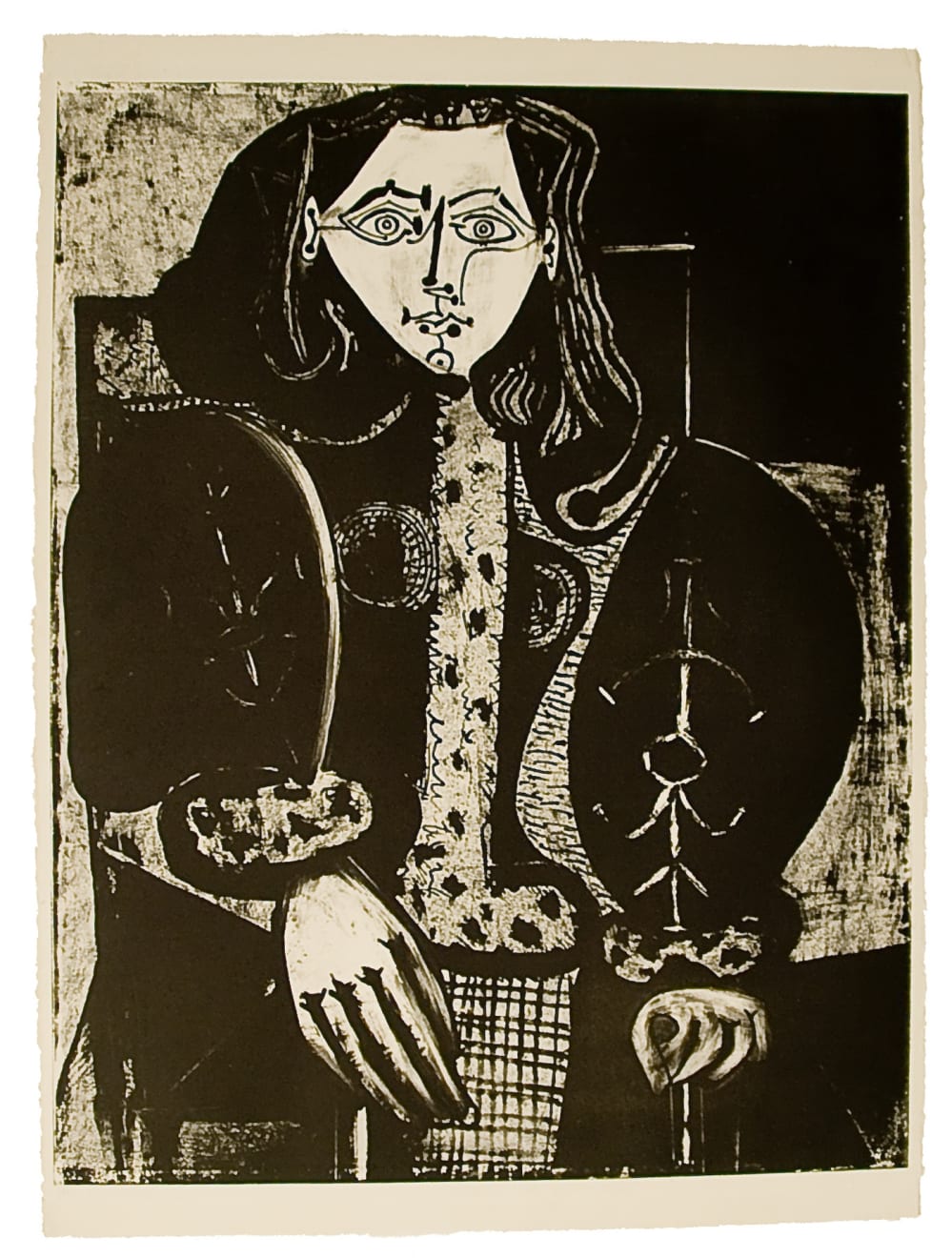PABLO PICASSO
Literature
Picasso’s most intensive period of activity in the medium of lithography took place between November 1945 and spring 1949, when he worked on some one hundred and eighty-five stones and plates, producing numerous extended sequences that he developed through many progressive states. The sequence to which Femme au Fauteuil No.1 belongs is a particularly complex example of this. In 1947 the artist had abandoned the heavy stone traditional to the lithographic process and had begun drawing his designs on zinc plates, allowing him to double the size of his images. Much lighter than the limestone blocks, the zinc plates could easily be carried back and forth for proofing and correcting between his studio on the rue des Grands-Augustins and Fernand Mourlot’s workshop at rue du Chabrol. This meant that Picasso was able to work any time of day or night altering and developing images, allowing him to give free rein to his obsessively creative engagement with the medium. In November 1948, Picasso decided to produce a large colorful lithograph portrait of his lover Françoise Gilot (born 1921) wearing the embroidered coat he had bought her during his recent trip to Poland. According to Mourlot, he composed the five colors of La Femme au fauteuil – yellow, red, green, violet and black – using a brush on litho paper, before the designs were transferred to five lithographic plates, each zinc representing one color of the five-color printing process.i Two states of this colored print were proofed, but neither was deemed satisfactory for editioning by the artist; instead he separated out the five zinc plates for extensive transformation using black ink. Each zinc plate was developed into a sequence of new permutations by drawing with a brush, a crayon and a pen, scraping and incising with glass paper and a needle, and erasing by polishing and cleaning. With each distinct plate, Picasso pushed his subject to an end point, branching off along the way as the urge took him, resulting in no less than twenty-seven different images.
Picasso worked the red plate first, picking it up on December 10th and taking it through six states before abandoning the zinc and working from a transfer that he had created from the fifth state on December 20th. The transfer was developed through four states, of which this is the second, made on January 13th 1949. As was usual for Picasso’s lithographs after 1947, six proofs were pulled for each state – five for the artist and one for Mourlot – before the editioning was decided. In the event only the fourth (and final) state of the transfer sequence was editioned from the red plate.
La Femme au fauteuil marks Gilot’s reappearance in Picasso’s lithographs after a break of eighteen months, and was perhaps stimulated by a serious altercation between them that had taken place that autumn. Pregnant with their second child, Gilot felt abandoned by Picasso when the artist flew to Poland with the poet Paul Éluard at the end of August 1948 to attend the World Congress of Intellectuals for Peace. Guessing that his daily telegrams to her had been faked by his chauffeur Marcel, she was furious with him when he returned. The embroidered sheepskin coats that he brought as gifts for her and their son Claude were no appeasement and she apparently slapped the artist and shut herself away. Begun in late October, Picasso’s painting of Gilot wearing the coat – Femme assise dans un fauteuil 1948 (reproduced in Picasso and Francoise Gilot: Paris-Vallauris, 1943-1954, exhibition catalogue, Gagosian Gallery, New York 2012, p.181, fig.32) may well have begun as an attempt at a rapprochement, as Charles Stuckey has suggested.ii It was unusual for Picasso to use a garment like this as a prop in his images: it seems very likely too that it was inspired by a painting by Henri Matisse (1869-1954) that had been on display in his retrospective at the Salon d’Automne in 1945. La Blouse roumaine 1940 (Centre Georges Pompidou, Paris) was exhibited again in December that year at Galerie Maeght surrounded by eleven framed photographs documenting the stages of its evolution.iii Gilot’s intense admiration for Matisse and the older artist’s ambition to portray her, which had been openly expressed during a visit that Picasso and Gilot made to Matisse in 1946, may well have spurred Picasso’s desire to compete with his old friend in making first the painting and then the series of prints in which the embroidered coat features heavily, partially transfused through his homage to Lucas Cranach in his David and Bathsheba prints of earlier in the year (Mourlot 109). The swelling of the sleeves into the leg-of-mutton shape recalls the renaissance imagery developed in this lithographic sequence. It is also visible in a painting that Picasso made that autumn, Maternité (reproduced in John Richardson, Picasso: The Mediterranean Years 1945-62, exhibition catalogue, Gagosian Gallery, London 2010, p.65), showing Gilot holding Claude who is wrapped in the plaid that reappears on Gilot’s skirt in many states of the lithograph. The stylization of Gilot’s features in this state of the print, and their fusion with the strong primitivist patterning that also decorates the sleeves, recall some of the primitive linear motifs employed in Picasso’s images of the Weeping Woman created over a decade before. Gilot’s wide-eyed hypnotic gaze shows her usual unbreakable confidence, the angular lines of her features perhaps expressing some of the artist’s frustration with her independent will.
Printed on Arches wove paper, this is one of the six proofs reserved for the artist and the printer of the second state of transfer; it is initialed by Fernand Mourlot, and annotated with his reference 134 / 2° etat du report and numbered 6/6 on the verso.
i Fernand Mourlot, Picasso Lithographs, Boston 1970, p.101.
ii ‘The Face of Picasso’s Lithography’ in ibid, p.182.
iii ibid, p.176 fig.24.
